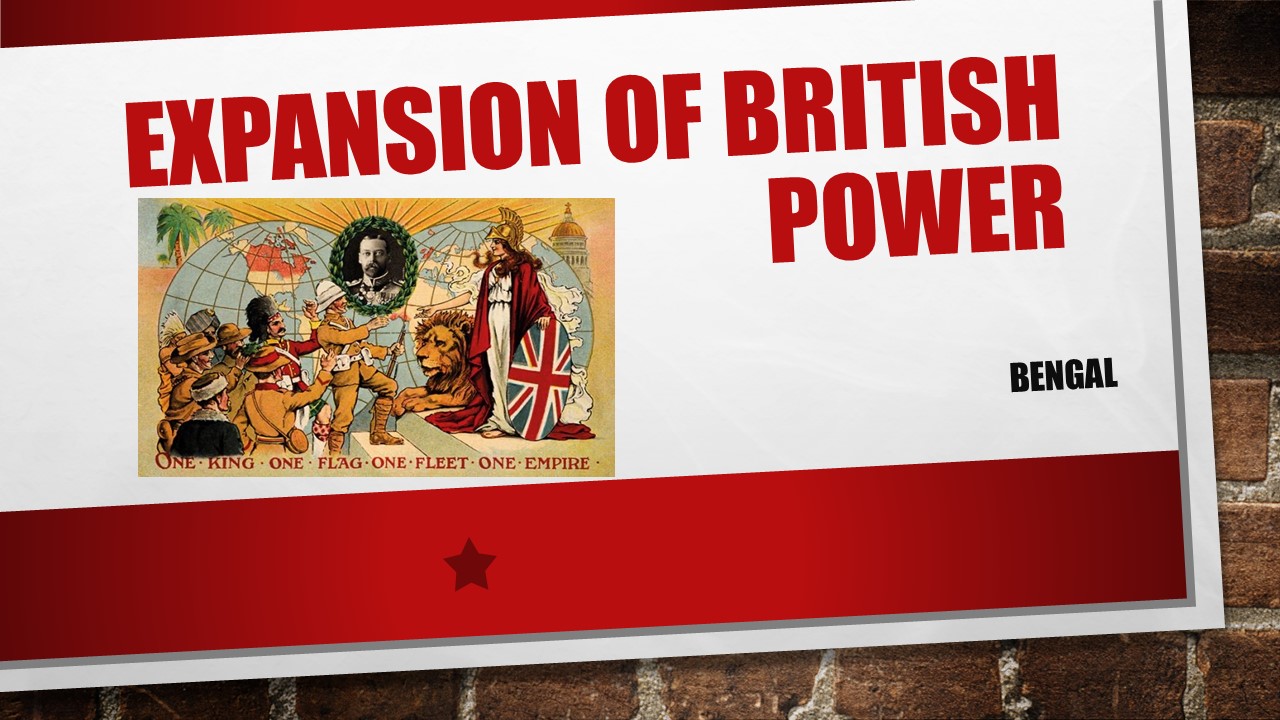
Expansion of British Power
Here’s a detailed explanation of the Expansion of British Power — focusing mainly on India, but also touching on global context:
The expansion of British power in India was a gradual yet calculated process, primarily led by the British East India Company under the guise of trade and diplomacy. Initially granted trading rights by the Mughal Emperor, the Company slowly transitioned from a commercial enterprise into a political power. This shift was marked by key military victories such as the Battle of Plassey (1757) and Battle of Buxar (1764), which allowed the British to gain control over revenue and administration in Bengal — one of the richest provinces. The British capitalized on internal rivalries among Indian rulers, forming strategic alliances, imposing the Subsidiary Alliance, and using the Doctrine of Lapse to annex territories. Alongside territorial expansion, the British reshaped India’s economic structure to suit their industrial needs by promoting cash crop cultivation, introducing new land revenue systems, and undermining traditional industries. This economic exploitation contributed to recurring famines and the impoverishment of rural populations. The British also imposed cultural and educational changes, introducing English education and Western legal systems while disregarding indigenous traditions. Although some infrastructure like railways, telegraphs, and roads were developed, these primarily served colonial interests. The growing resentment and discontent eventually culminated in the Revolt of 1857, which, despite its failure, marked a turning point—ending Company rule and beginning direct governance by the British Crown through the establishment of the British Raj in 1858.
🇬🇧 Expansion of British Power (17th to 19th Century)
The expansion of British power, particularly through the British East India Company and later the British Crown, marked a significant phase in global history. Britain transformed from a trading presence into a global colonial empire.
1. Early British Entry into India (1600s–1700s)
- 1600: The British East India Company was granted a charter by Queen Elizabeth I to trade with the East.
- Established trading posts (factories) in Surat, Madras, Bombay, and Calcutta.
- Faced rivalry from the Portuguese, Dutch, and French for control over Indian trade.
2. Key Battles & Political Expansion Battle of Plassey (1757)
- Turning point. Robert Clive defeated Siraj-ud-Daulah, the Nawab of Bengal.
- Gave the British control over the rich province of Bengal.
Battle of Buxar (1764)
- British defeated the combined forces of Mughal Emperor Shah Alam II, Nawab of Awadh, and Nawab of Bengal.
- Secured Diwani rights (tax collection) over Bengal, Bihar, and Orissa.
3. Methods of Expansion
- Wars and Alliances: British fought wars (Anglo-Mysore, Anglo-Maratha, Anglo-Sikh) and made alliances to expand territory.
- Subsidiary Alliance (by Lord Wellesley): Indian rulers had to accept British troops and could not keep their own army.
- Doctrine of Lapse (by Lord Dalhousie): Territories without a natural heir were annexed.
- Annexation: Punjab (1849), Awadh (1856), and many princely states were annexed by mid-19th century.
4. Economic and Administrative Control
- Drain of Wealth: Profits from Indian resources and labor were transferred to Britain.
- Land Revenue Systems:
- Zamindari System (Permanent Settlement) in Bengal
- Ryotwari System in South India
- Mahalwari System in North India
- Commercialization of Agriculture: Cash crops like indigo, opium, cotton were encouraged for British industries.
5. From Company to Crown Rule (1858)
- Revolt of 1857 (First War of Independence): Failed uprising by Indian soldiers and rulers against British rule.
- 1858: British Parliament passed the Government of India Act — the East India Company was dissolved, and India came under direct Crown rule (British Raj).
- Viceroy system established — Queen Victoria declared Empress of India in 1877.
6. Global British Expansion (Beyond India)
- Africa: Colonies in Egypt, South Africa, Nigeria.
- Southeast Asia: Control over Burma (Myanmar), Malaya (Malaysia).
- Australia, Canada, Caribbean: Settler colonies formed a global empire.
- By the 19th century, Britain became the largest colonial empire, often called “the empire on which the sun never sets.”
Summary of Impact
| Positive Aspects | Negative Aspects |
|---|---|
| Railways and postal systems | Destruction of local industries |
| Legal and administrative reforms | Exploitation of Indian economy |
| Modern education introduced | Cultural domination and racism |
| Infrastructure like roads | Famines due to cash crop focus |
Would you like a timeline, presentation slides, or a comparison with French or Mughal power?



